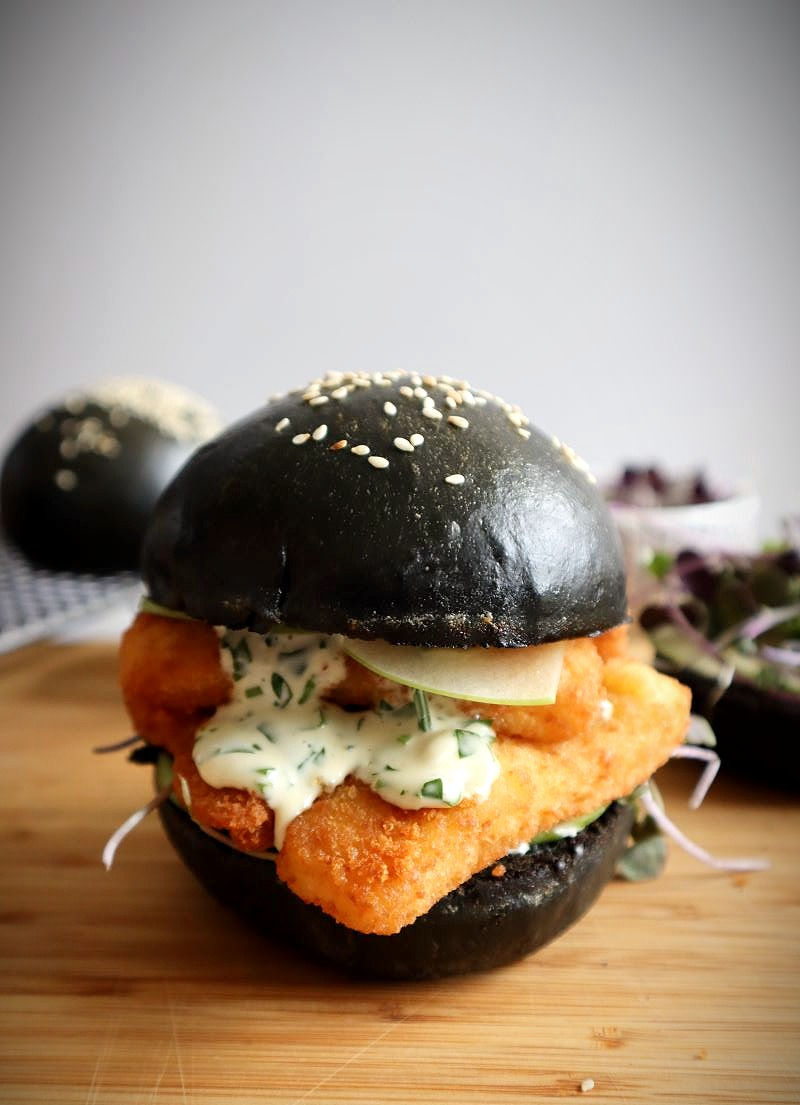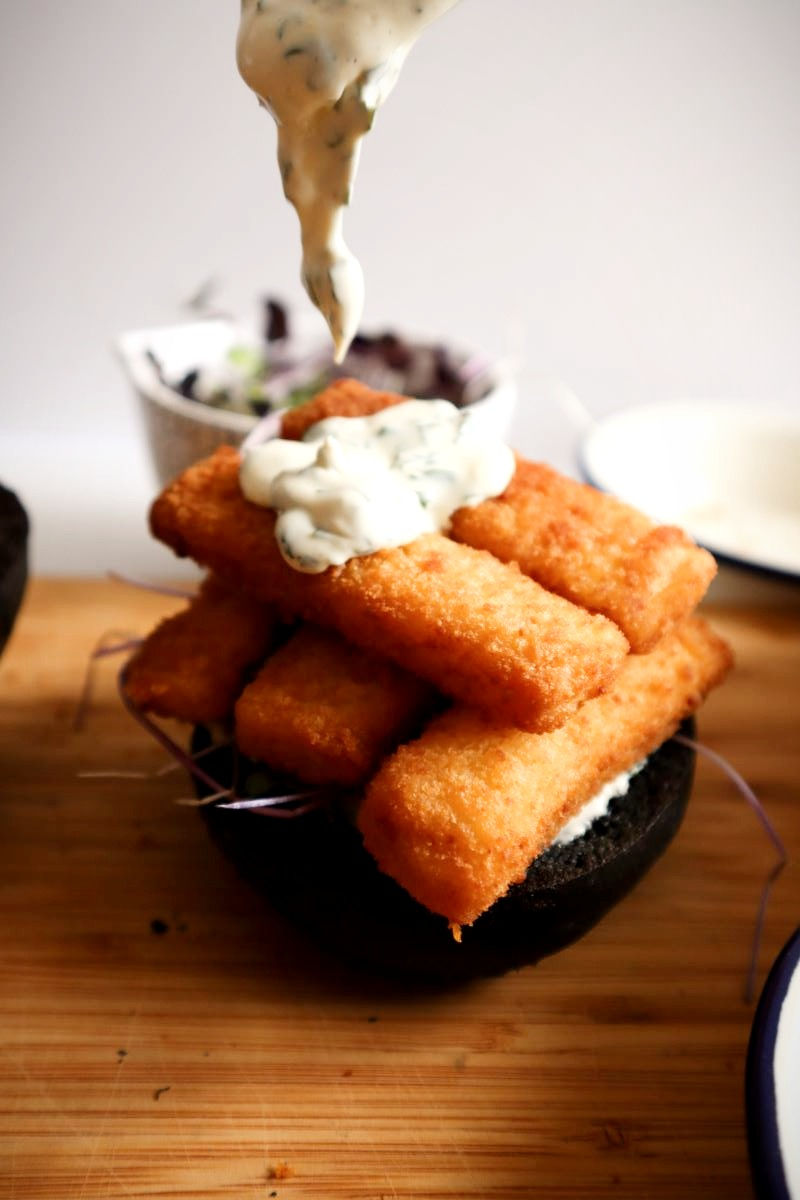Charcoal Burger Bun | Fish Fingers with Slice Apple and Dijon Tartare
- Christean N.

- Aug 27, 2021
- 4 min read
Updated: Jul 13, 2023


As a kid, fish finger is like a weekend treats. I have actually long forgotten about my childhood favourite until my husband came home with a pack of them which prompts me to make this burger.
Topped with house made Dijon Tartare sauce and slice apple, this burger is so delicious I just want to share the recipes with you. I have also included my go to soft Tang Zhong Burger bread roll made with activated charcoal. If you cannot find activated charcoal, you can omit that in the recipe, or check out my other post that uses the plain burger bun recipe on Fried Chicken Burger.
I hope you enjoy this burger as much as we do and let me know what you think!
RECIPE
Yield: 4 Burgers
Charcoal Burger buns - makes 4 burgers
Tang Zhong
35 g 12% Milk
7 g 4% Baker's Flour
Final Dough 250 g 96% Baker's Flour (12% Protein)
4 g 1.6% Activated Charcoal Powder 80 g 30% Full Cream milk - 35 3 g 1.1% Fine sea salt 5 g 1.5% Instant Yeast 20 g 7.6% Caster sugar 30g 11% Unsalted butter - room temp. 50 g 19% Large eggs (1 Large Eggs)
Dijon Tartare Sauce
80 g Kewpie Mayonnaise
2 tsp Lemon Juice
1 tbsp. Sour Cream or yoghurt
10 g Chopped fresh Parsley
1 tsp. Dijon Mustard
Qs. Salt and Pepper - to taste
Assembly
20 Fish Fingers- oven baked
3 tbsp. Butter
100 g Micro Salad Mix
Qs. Salt and Pepper To Taste
qs. Siracha (optional)
1 Green Apples - cored and sliced thinly
Method
Prepare the dough
1. Start by making the Tang Zhong. Place the milk and flour into a small saucepan over medium heat and keep whisking until it starts to thicken to a paste. This process will not take long at all, so don't walk away from it since it is a very small amount. Once the Tang Zhong is ready, place into a clean bowl and wrap with a cling film touching the surface and leave to cool completely.
2. Once the Tang Zhong have cooled, prepare the Final dough. Gently heat the milk in the microwave and bring it to 35°C. Sprinkle a pinch of sugar into the milk then whisk in the instant yeast. Leave at room temperature for approximately 10 to 20 minutes until it becomes frothy.
3. In a stand mixer bowl fitted with a dough hook attachment place the flour, salt and sugar and mix slightly to combine. Add in the eggs and milk/yeast mixture and continue to mix on low speed for 3 minutes until they come together to form in to a dough. Scrape down the side and the bottom of the bowl if necessary.
Add in the room temperature butter and continue to mix for approximately 12 to 15 minutes at medium speed, scraping the side and base of the bowl when necessary. The dough will start looking really wet at this point, but keep mixing as it will eventually come back to a smooth dough again. Scrape the side and bottom of the bowl when necessary.
When the dough is ready, it should start to pull clean away from the side of the bowl and feels pliable. If you pinch a small piece of the dough and gently stretch it between your two hands, you should be able to stretch it thin enough to see through. This is an indication that you have developed enough gluten and the dough is ready to be shaped and to be bulk ferment.
4. Lightly dust your work surface with some flour then transfer the dough over. Roll the dough to a semi tight ball then place it into a lightly greased bowl large enough for it to double in size then cover the bowl with a slightly damp tea towel. Leave to bulk ferment at room temperature. This will take approximately 1 to 2 hours depending on the ambient of your kitchen.
5. When the dough have doubled in size, knock back the dough by pressing gently in to the dough to release some of the excess gas and divide into 4 equal sized portions of approximately 110 g each. Working with one or two dough at a time, fold all corners of the dough to the centre then turning the folded sides facing down onto the bench top, curve your palm slightly around the side of dough, then roll the dough to a smooth ball, tightening it slightly. Continue this process until you have rolled all of the doughs.
Place the burger buns on to baking tray lined with parchment paper then cover with a damp tea towel and leave for 20 minutes to 45 minutes (depending on the ambient of your kitchen) until the buns rises slightly again and feels airy when you gently try to move it.
Meanwhile, pre heat the oven to 170 °C.
6. When the buns are ready, prepare the egg wash by whisking the eggs and milk together then gently brush the top of each buns. Sprinkle with the sesame seeds (optional). Do not over brush the buns with the egg wash as this can cause them to darken too much before the interior are fully baked. Just a gentle brush on the top and sides.
Place the tray into the pre heated oven and bake for approximately 20 minutes or when the top starts to turn golden brown in colour. If you are unsure if the buns are fully cooked on the inside, probe the thermometer into one of the buns from the sides and it should read at least 90°C / 310°F.
Remove the baked burger buns from the oven and transfer onto a wire rack to cool. Don't leave breads cooling on a hot tray as this can cause the base of the buns to retain the steam and become soggy.
Assembly
Mix all the ingredients together for the Tartare sauce. Slice the burger buns to half horizontally then heat a frying pan generously with butter. Place the buns cut side down on to the hot pan to soak up all of the butter. Spread some of the tartare sauce on top of the flat side of the buns, then place 2 to 3 thin slices of the granny smith apples on top of the sauce. Top with 4 to 5 pieces fish fingers then top with more apple slices and tartare sauce. Drizzle the top with some siracha (optional) then serve!
VIDEO SUMMARY




Comments